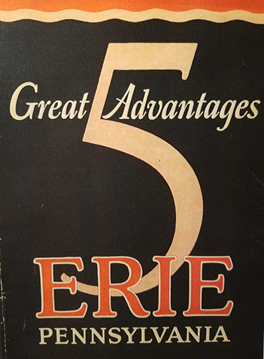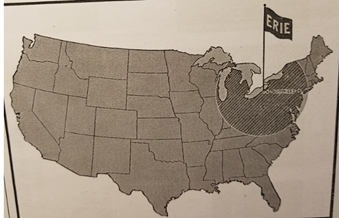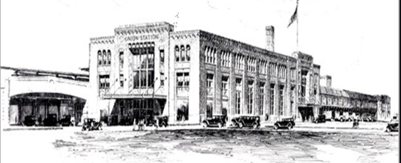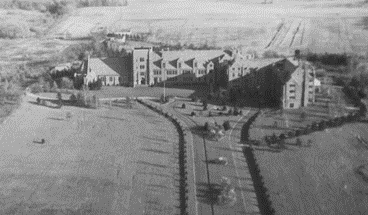The year is 1926: Calvin Coolidge is President; Gifford Pinchot is the Governor of Pennsylvania and Joseph Crane Williams is Mayor of the City of Erie. The Erie Chamber of Commerce produces a booklet about the benefits of Erie to manufacturing, whether new or relocated. What were they and are they still applicable today?

#1 Geographic Location
If you were to draw a circle on a map with Erie being in the center, it would encompass 1/10th of the land mass of the United States at the time (no Alaska or Hawaii then). It would also include roughly ½ of the population of the country and the most populated areas of Canada. Erie is approximately ½ way between New York City and Chicago and not far from the automobile production capital of Detroit, the rubber production capital of Akron, and the iron and steel centers of Pittsburgh and Cleveland.

#2 Transportation
Erie had 4 major railroads that went through town: the New York Central, Pennsylvania, Nickel Plate, and Bessemer lines with 52 passenger trains stopping here every day. Plans were in the works for a brand new $1,000,000 train station, the current Union Station (named that because it was co-owned by the New York Central and Pennsylvania railroads) in 1927. In 1926, 40,000 freight cars were loaded and unloaded in Erie in that year alone.

Erie’s harbor was first rate with rail capabilities right at the port. Shipping occurred not only throughout the Great Lakes but was projected to be worldwide with the completion of the St. Lawrence Seaway which eventually was completed in 1959.
#3 Skilled, Intelligent Workers
With 32 public schools and 17 parochial schools and a higher-than-average graduation rate, Erie students were well prepared for the workplace. Business schools flourished and Mercyhurst College opened its doors in 1926. Employees earned a high standard of living with half of families able to own their own home. Erie also had the lowest per capita tax rate of 27 industrialized cities polled.

#4 Basic Raw Materials in Easy Reach
Iron ore from Lake Superior and pulpwood from Canada travelled inexpensively on the Great Lakes. Coal cost less than $3.20 a ton when shipped by rail to the city. Other natural resources located in the vicinity fed the widely diversified industry found here. The booklet gives the quote “anything short of a complete national depression has but little effect upon Erie businesses”. Now that is optimism!
#5 An Abundant Water Supply
Clean and inexpensive, the water here is available not only for business but for pleasure also as water sports are extremely popular. The climate also supports a healthy lifestyle for work and play. On average for the prior 20 years there were only 3.1 days of sub-zero temperatures and 2.7 days of days over 90 degrees. The average daily temperature is 48.8 degrees, which scientists have shown is approximately the ideal temperature for worker efficiency. The lake protects citizens of Erie from temperature extremes and allows for cool summer nights giving a restful sleep and energy for workers to have sustained efficiency. We also have ample rainfall for local crops.

What do you think? Are the benefits of Erie still applicable today? In my opinion, I believe most of them still help make Erie great. Sure, we do not have the rail transportation that 1926 had, but now we have airplanes. The nation’s population has moved more south and west but as we learned during the pandemic, people can live in one part of the country and work somewhere completely different with telecommuting. High tech startup companies are choosing Erie due to the lower costs associated with living here. I have lived in other parts of the country and overall, Erie is less expensive except for maybe property taxes (sorry Mayor Schember). Yet, I choose to focus on the happiness Erie history and everyday living brings me for a hopefully long life here.
